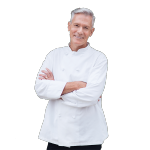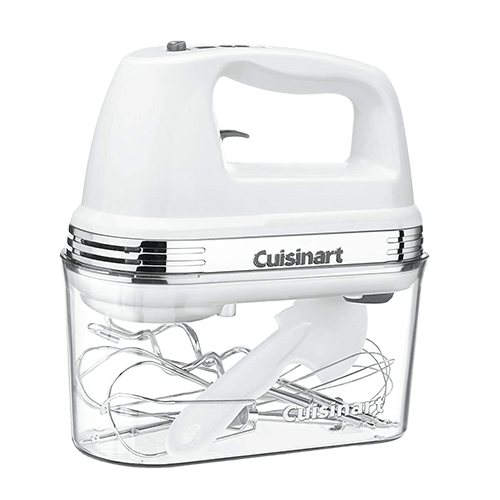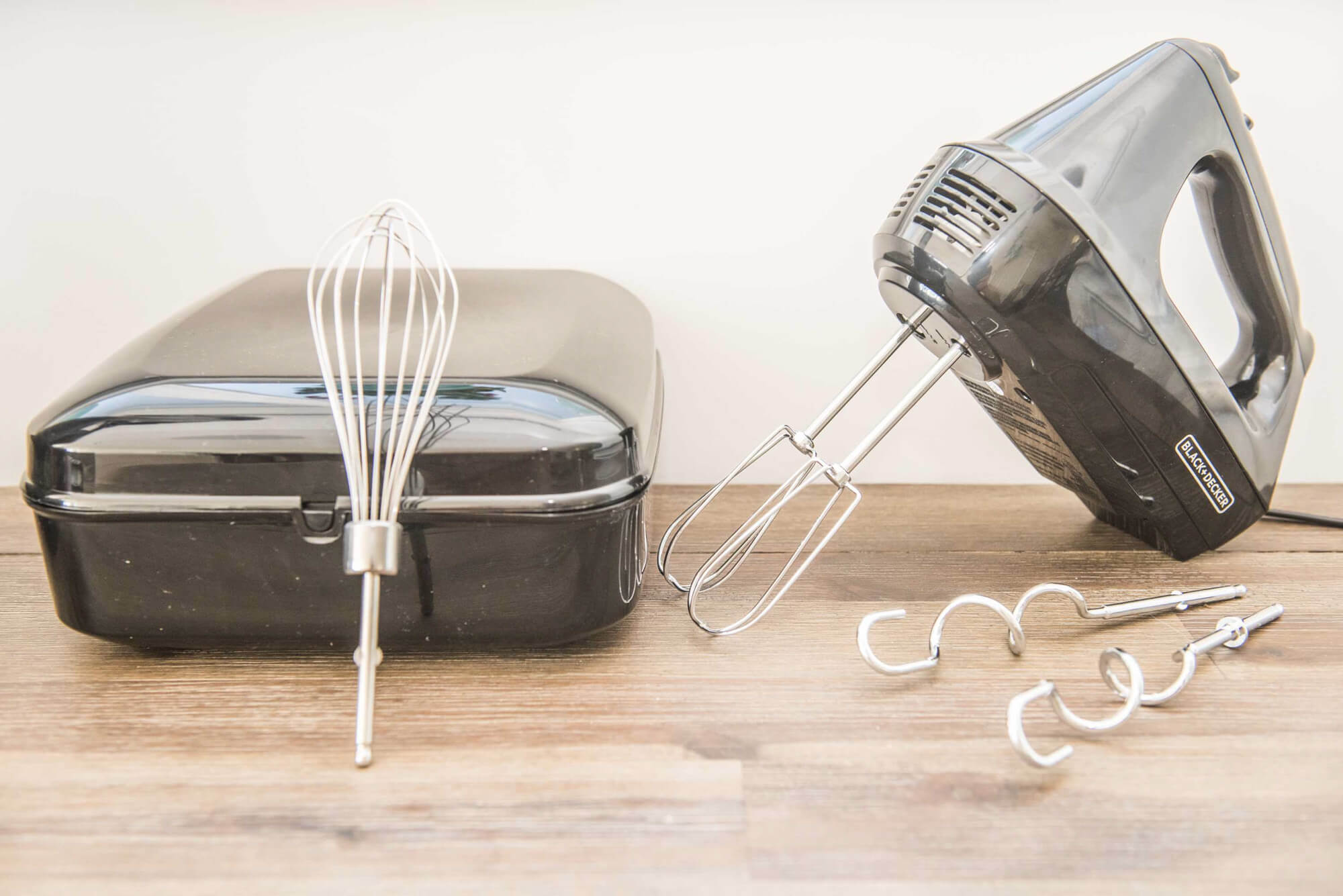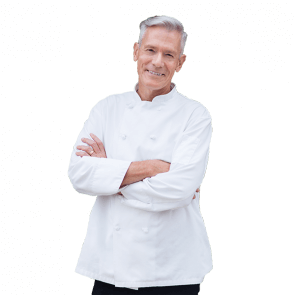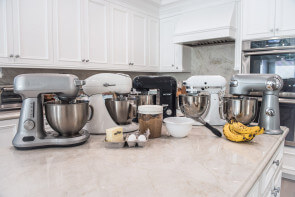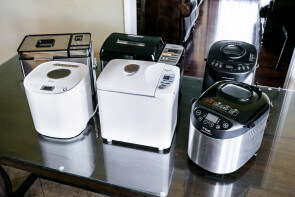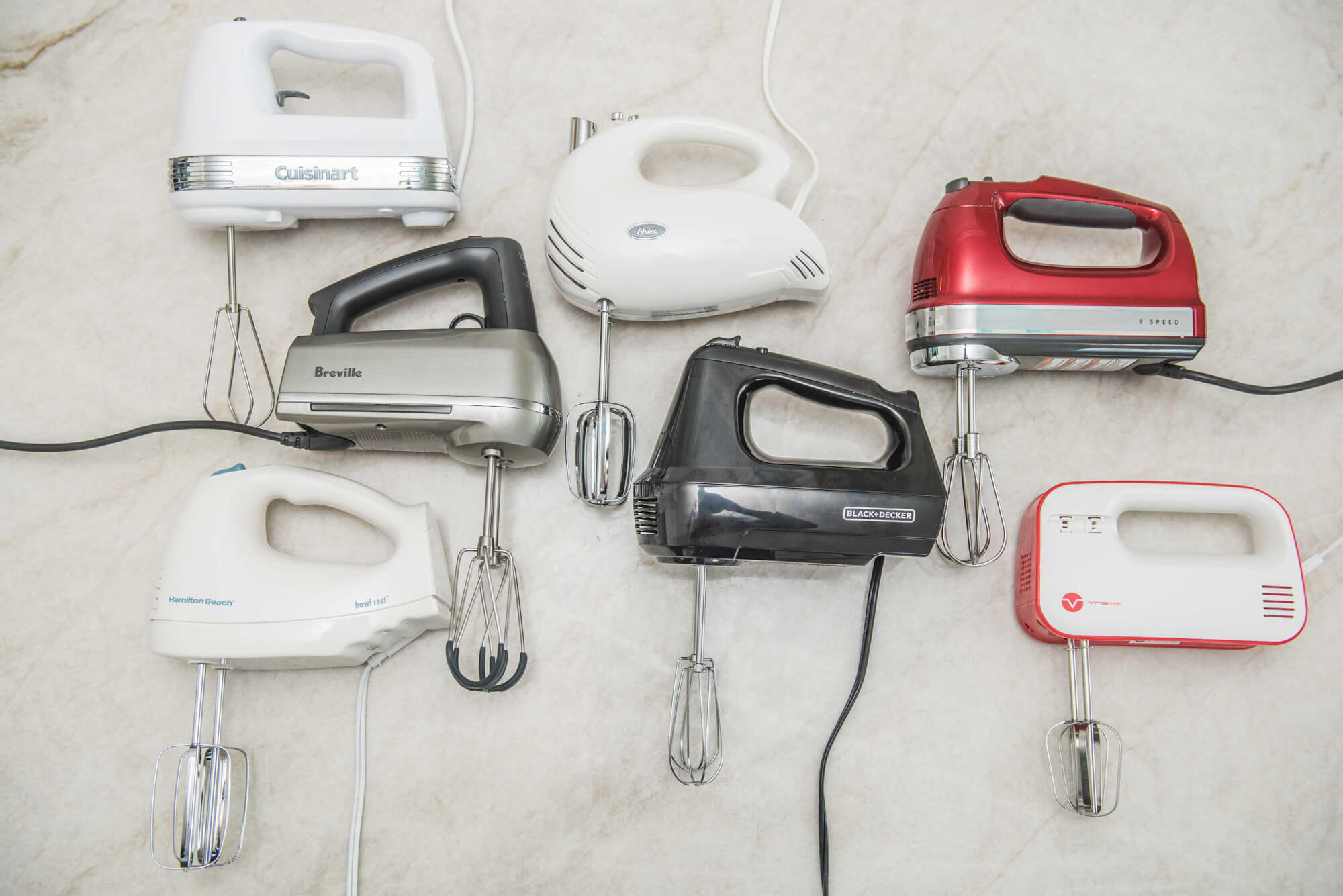
The Best Hand Mixers
After 40 hours of baking cakes, kneading bread and mashing 20 pounds of potatoes, we determined that the Breville – BHM800SIL is the best hand mixer. Its smart ergonomic design and intuitive nine-speed controls surpassed the other six hand mixers we tested. The Breville whipped egg whites faster, blended cake batter more thoroughly and was by far the easiest to use. Our runner-up is the Cuisinart – HM-90S, and the Oster – 2500 is our budget pick.
After 40 hours of baking cakes, kneading bread and mashing 20 pounds of potatoes, we determined that the Breville – BHM800SIL is the best hand mixer. Its smart ergonomic design and intuitive nine-speed controls surpassed the other six hand mixers we tested. The Breville whipped egg whites faster, blended cake batter more thoroughly and was by far the easiest to use. Our runner-up is the Cuisinart – HM-90S, and the Oster – 2500 is our budget pick.
Table of contents
- Compare the best hand mixers
- 1. Top pick: Breville – BHM800SIL
- 2. The runner-up: Cuisinart – HM-90S
- 3. Budget pick: Oster – 2500
- Other hand mixers we tested
- How we selected hand mixers to test
- How we tested
- Important features to consider
- Who needs a hand mixer?
- The bottom line
Compare the best hand mixers
| Product | Price | Speeds | Ease of Use | Performance |
|---|---|---|---|---|
| 1. Breville - BHM800SIL | $$$$ | 9 | 5 / 5 | 5 / 5 |
| 2. Cuisinart - HM-90S | $$$ | 9 | 5 / 5 | 4.5 / 5 |
| 3. Oster - 2500 | $ | 5 | 4 / 5 | 4.5 / 5 |
| 4. KitchenAid - KHM926WH | $$$ | 9 | 4 / 5 | 4 / 5 |
| 5.Hamilton Beach - 62650A | $$ | 6 | 3 / 5 | 3 / 5 |
| 6.Vremi - VRM010008N | $ | 3 | 3 / 5 | 2 / 5 |
| 7.Black+Decker - MX3200B | $$ | 6 | 3 / 5 | 2 / 5 |
1. Top pick: Breville – BHM800SIL
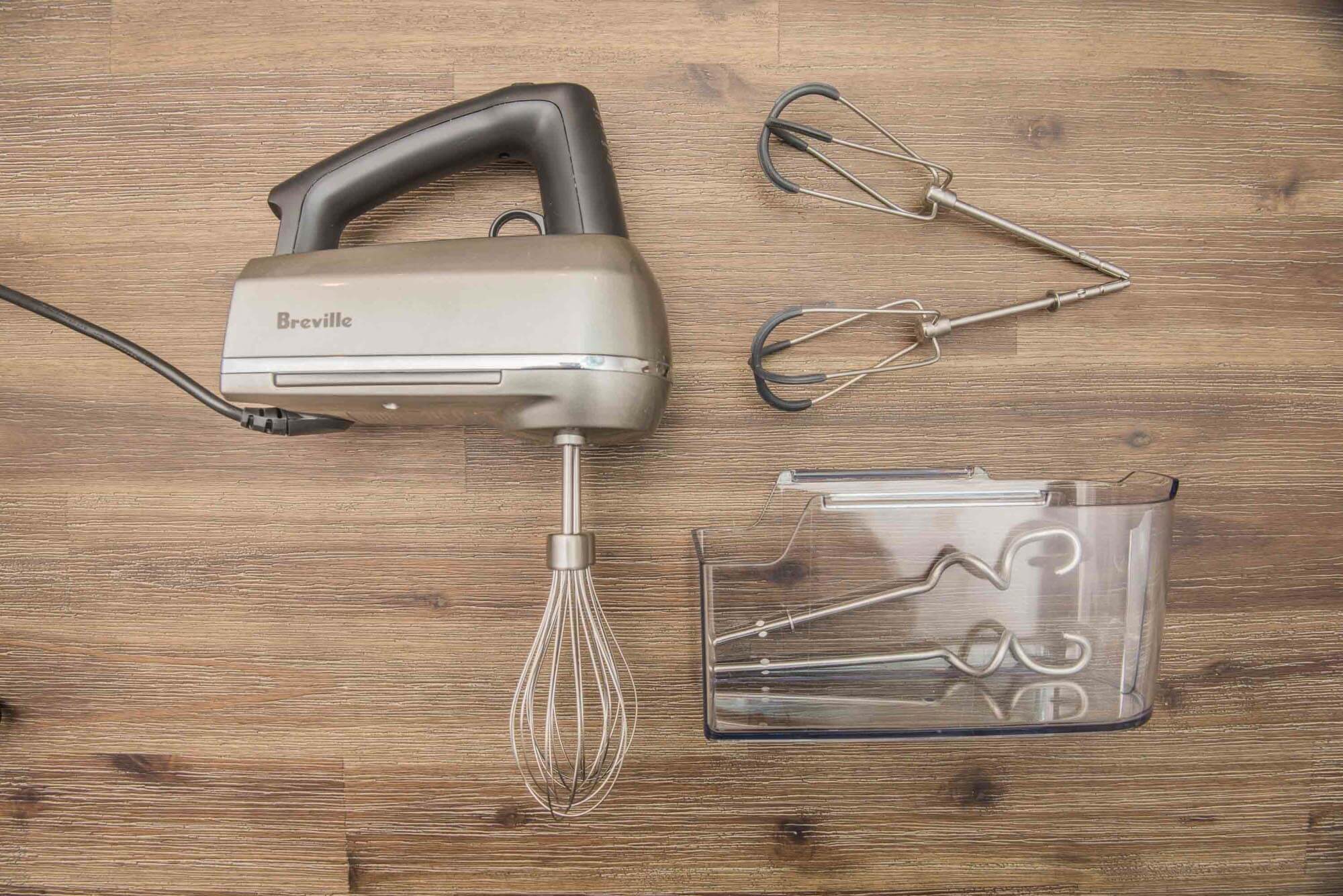
Thoughtful design and superb engineering handily elevated the Breville – BHM800SIL nine-speed hand mixer to the top. The Breville is the most expensive of the hand mixers we tested, but if you’re serious about baking, the Breville is a worthwhile investment.
The Breville has a number of unique features that set it apart. Physically it’s been designed to fit ergonomically in your hand. Its handle rests comfortably in your palm, and although it’s a bit heavier than other models, it glides around a mixing bowl almost by itself. You simply guide the mixer where you want it to go. An unusual feature is a trigger ring fitted for your forefinger. It’s actually the eject mechanism, but it also contributes to the mixer’s maneuverability in your hand.
As mentioned earlier, the scroll wheel for adjusting speed levels is remarkably easy for increasing or decreasing speed. Above the wheel is an LED panel with a speed indicator and a timer that begins timing when the mixer is turned on and pauses timing whenever the pause button is pressed.
The Breville’s electrical cord has a plug with a finger-hole for rapid removal from a socket, and most impressively, the base of the cord in the mixer’s chassis swivels, so it can be used by both right- and left-handed people. As if these design elements weren’t enough, the Breville has a light located between the beaters that shines into your mixing bowl each time you power on.
Top Pick: Breville - BHM800SIL
Superb engineering and lots of bonus features, such as a mixer light and scroll-wheel speed adjustments, make this a great hand mixer for the frequent baker. This mixer comes at a higher pricer point, but it delivers outstanding performance and ergonomics, including a swivel cord and trigger ring that improves your maneuverability in the bowl.
The Breville’s stainless-steel attachments include two silicone-coated beaters, which didn’t clatter against our mixing bowls and also virtually eliminated scraping down ingredients, two dough hooks and two wire whisks. No other hand mixer has two whisks, and the Breville’s easily doubled the volume of egg whites to fluffy heights in a minute.
An especially remarkable engineering feat is the mixer automatically adjusts the range of speed depending on which attachments you insert. For example, the dough hooks need less speed than the whisks or beaters. So when you insert the dough hooks, the mixer’s low speeds decrease so they’re low enough that flour doesn’t splatter when added.
The Breville’s performance matched its design in excellence. Our only complaint — and it’s the same for all of the blenders we tested — is the dough hooks do a good job of combining the ingredients into a blended dough, but kneading gave us trouble. Even at a low speed, we had to fight the dough from climbing up the sides of the bowl.
The Breville’s hefty price tag might discourage casual bakers or cooks, but we do believe this is an exceptional hand mixer for someone who really enjoys baking. The Breville whips through any baking task with little effort and could inspire you to bake more than the once-a-year birthday cake or Christmas cookies.
Key takeaways:
- The Breville – BHM800SIL’s smart, ergonomic design allows the mixer to fit comfortably in your hand.
- Its motor automatically adjusts speed levels depending on the attachments inserted.
- Special features include an LED timer and speed indicator, whisper-quiet motor and a mixer light that illuminates what you’re mixing.
- The Breville’s unique swivel cord for right- and left-handers also increases maneuverability in a mixing bowl.
2. The runner-up: Cuisinart – HM-90S

The Cuisinart – HM-90S is about one-third less expensive than the Breville, and although it doesn’t quite match Breville’s outstanding performance, it’s nonetheless a very good hand mixer for the price.
It has nine speeds, each one noticeably increasing at small increments, which gave us a real sense of control. The three slow speeds are indeed very slow and were great for incorporating flour and sugar without any splatter. We didn’t find much difference between the middle speeds and settled at speed 5 as the most effective, particularly for whipping potatoes.
Cuisinart’s instruction manual helpfully suggests speeds and attachments for certain foods, which we tested out. The suggestions proved to be mostly accurate, although we did find that increasing the suggested speed by one level gave us quicker results.
The mixer fits comfortably into the grip of your hand, and although the power button might be slightly too high up to reach for some people’s thumbs, the speed control buttons are at thumb level. The mixer’s speed automatically reset at level 1 each time it’s turned off, and there’s a bit of a surge before it adjusts to the actual speed level. Once we got used to that, it didn’t present a problem; we simply waited for a second or two before lowering the beaters into the bowl.
Maneuverability is excellent, thanks to the mixer’s lightweight and a swivel base for the electric cord, so you can move around the mixing bowl without the cord getting in your way.
The Cuisinart has the usual attachments (including a nifty little bowl scraper), but the beaters are longer and wider than those of other mixers we tested, which gave us great coverage in the mixing bowl when blending the cake batter. As with most of the mixers, a snap-on storage case for the attachments is a welcome addition.
The Cuisinart performed well in all of the tests, and as was the case with the Breville, the dough hooks efficiently combined the dough ingredients but had trouble keeping the dough in the bowl during the kneading process, even at the slowest speed.
The Cuisinart is still a bit expensive for a hand mixer, but it’s very well made and is sure to last. It comes with a three-year warranty, which is remarkable for a kitchen appliance (most are one-year), and any replacement parts are readily available and not expensive. If you don’t want to shell out big bucks for the Breville, then we recommend the Cuisinart HM-90S as our second-place winner.
Key takeaways:
- The Cuisinart – HM-90S is compact yet powerful with plenty of speed to plow through thick doughs and whip egg whites and cream in under two minutes.
- Its stainless steel attachments are sturdy and easy to clean.
- The Cuisinart’s three-year warranty is unique for a hand mixer.
- It’s a bit pricey, but it’s durable and designed to last for years.
3. Budget pick: Oster – 2500
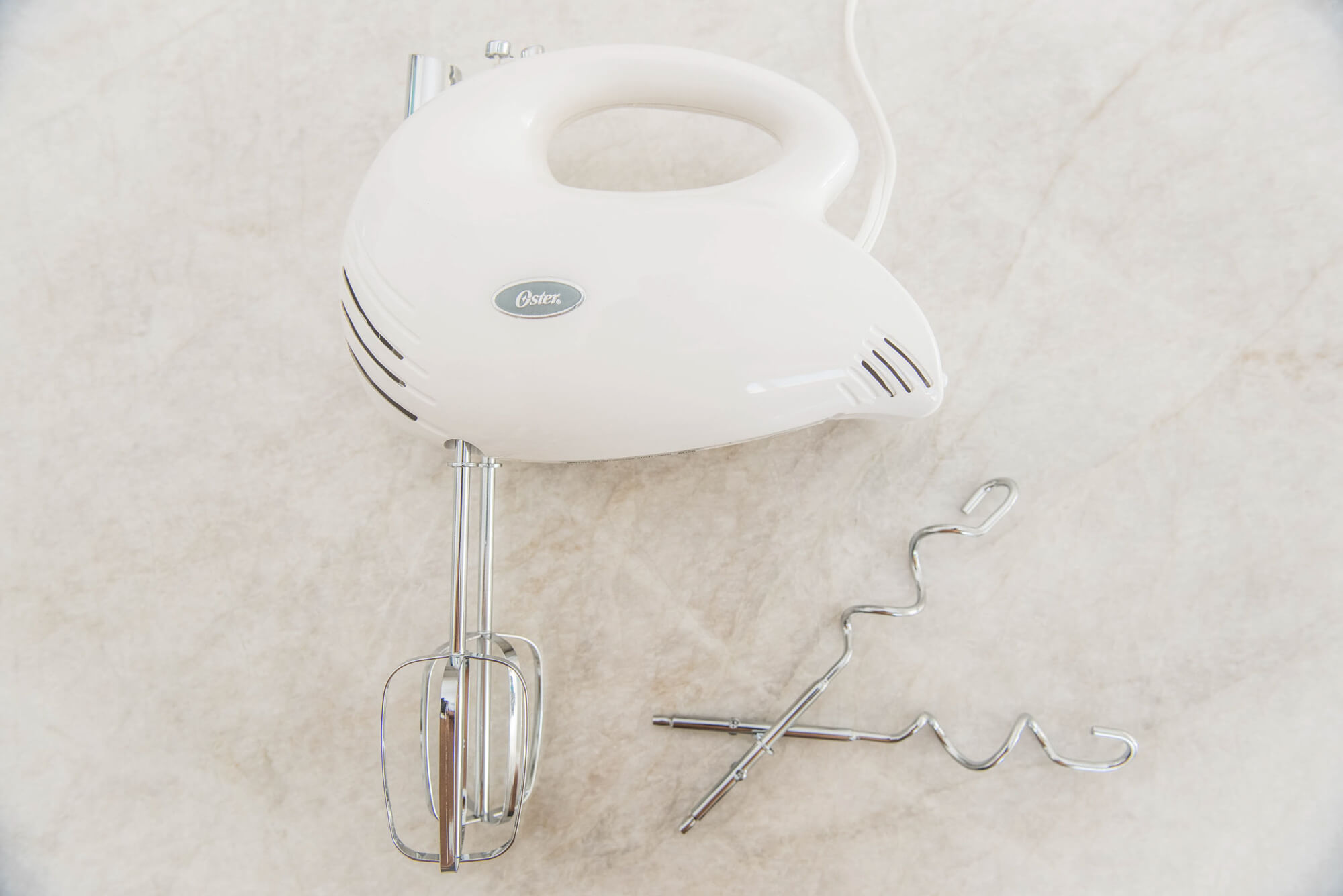
The majority of hand mixers we tested run in the $15 to $20 range, and the best of them was definitely the Oster – 2500. At 240-watts, the Oster is actually a bit more powerful than our runner-up, the Cuisinart HM-90S. It has five speeds, each of which is clearly differentiated, unlike most nine-speed models.
The Oster is a bit larger and heavier than the other hand mixers we tested, and in some ways, reminds of us of the hand mixer our mother (or even grandmother) might use. The beaters are made of chrome and are thicker, like the old-fashioned models, intended for creaming butter and mixing thick cookie or bread doughs. The beaters were a little more difficult to clean, but they gave us good volume with egg whites in one minute and smooth blending of pizza dough.
Of the competition, its slowest speed didn’t splatter dry ingredients, and at the fastest speed, it tore through the potatoes like a little motor boat.
The Oster is a little heavy in the hand, so it may not be ideal for people who have hand or wrist weakness. We also found the chrome lever for adjusting speeds and the eject button to be stiff.
These quibbles don’t stand in the way, however, of our recommending this hand mixer as a good product at a great price.
Key takeaways:
- The Oster – 2500 is more powerful than the other comparably priced mixers we tested.
- Its large beaters gave excellent volume to egg whites and whipping cream.
- Each of the Oster’s five speeds is precisely differentiated from lowest to highest.
Other hand mixers we tested
KitchenAid – KHM926WH

The KitchenAid – KHM926WH is another 9-speed hand mixer and shares several features with the Breville. It fits nicely in the hand and has also been designed for easy operation and maneuverability.
There’s a lot to like about the KitchenAid. Its large wire whisk is efficient and added good volume to the egg whites and whipping cream. We also found it helpful that the chassis is marked with symbols for how the attachments should be inserted. Oddly, the KitchenAid’s eject button isn’t marked.
However, as we found with the other mixers, its nine speed levels aren’t differentiated much to matter, since each increment between speeds is minimal. Its lowest levels were lower than the other mixers, and its highest levels were too high, splattering anything we attempted to mix.
The KitchenAid – KHM926WH is comparable in price to the Cuisinart, which in our testing, we found to be superior.
Hamilton Beach – 62650A

The Hamilton Beach – 62650A has many of the same features as the other hand mixers we tested: beaters and whisk attachments, snap-on storage case and good wattage (250 watts). It’s got six speeds with not much difference between speeds three and four, but the lowest speed and the highest speed are much too high for incorporating dry ingredients or mixing anything without splatter.
Its lever for changing speeds is awkwardly placed, so you really need to stretch your thumb high up on the mixer to reach the upper speed levels. It doesn’t have a separate eject button, but instead eject is done by pushing on the speed lever, which can stick. The Hamilton Beach – 62650A is certainly reasonably priced, and we did like its unique bowl rest feature on the base of the mixer, but for a bargain-priced option, we’d recommend the Oster – 2500 instead.
Vremi – VRM010008N
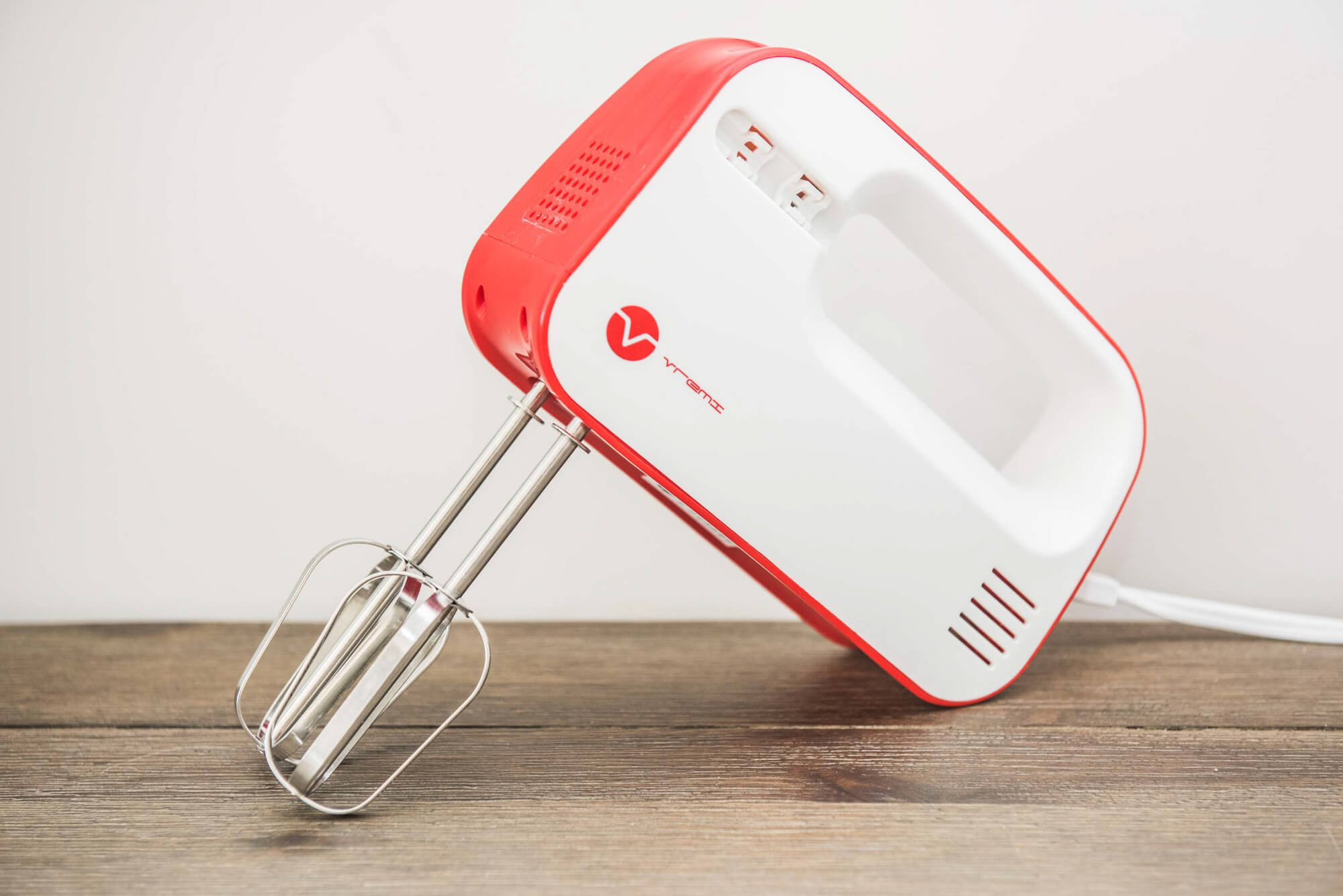
We really wanted to love the Vremi – VRM010008N. First of all, it’s adorable. The Vremi is a tiny candy-apple red hand mixer with 150 watts. It’s compact, could fit in a drawer and designed so its beaters (the Vremi’s only accessories) fit right into the chassis of the mixer. The Vremi is very lightweight and can whizz around a mixing bowl with no effort.
Unfortunately, its low wattage does this little mixer in. The Vremi has the flaws of some of the other mixers we tested. Its speed button is difficult to move while you’re mixing something, and the low speed splatters dry ingredients everywhere. Even at its highest speed, the Vremi struggled to plump up the egg whites and whipping cream.
The Vremi is an inexpensive option for a tiny kitchen. But its low wattage increases the time and effort in doing basic baking tasks.
Black+Decker – MX3200B
The Black+Decker – MX3200B has little differentiation between the speeds. Although it has six speed settings, in actuality, it’s a three-speed mixer — the two lows, mediums and highs are virtually the same.
The Black+Decker did a nice job in whipping the egg whites, and it creamed the potatoes to a smooth consistency. We found there was a lot of splatter, however, even at its lowest speed. Oddly, the mixer doesn’t stand up easily on its end, so we had to balance it against the mixing bowl. The Black+Decker was, by far, the loudest of the mixers we tested.
It has a plastic storage case for the entire mixer, which no other mixer we tested had, and it’s reasonably priced. But since the Black+Decker’s lowest speed isn’t low enough to prevent splatter of dry ingredients, we believe you should buy our budget pick, the Oster – 2500, instead.
How we selected hand mixers to test
We began our research by reading hundreds of reviews of hand mixers posted on Amazon, focusing on those that had the highest ratings. From there we went to the manufacturers’ websites for the hand mixers we were interested in testing to compare features and accessories.
The majority of hand mixers run about $20 or less, and they’re very similar in appearance, wattage and accessories. But we also wanted to test higher-end models to determine if their additional features were worth the increased price.
Included in our research was reading reliable and authentic reviews of hand mixers posted by other review sites to learn what criteria each used to test and rate hand mixers.
We also read through several Reddit threads to learn how people use hand mixers and what’s important for them when they’re considering buying a new one. We compared user recommendations with those other online product reviews, then culled through the hand mixers that are the newest models, or currently available, to settle on the seven hand mixers we would test.
How we tested
Our tests comprised the most common baking tasks for a hand blender:
- Whipping egg whites into a fluffy meringue.
- Whipping heavy cream into stiff peaks.
- Combining dry ingredients with wet ingredients without splatter.
- Creaming butter and sugar evenly.
- Blending cake batter to a smooth consistency.
- Churning heavy doughs like cookie, bread or pizza.
- Kneading bread or pizza dough.
We chose this recipe for a sponge cake for testing whipping, combining and blending and this basic recipe for bread for churning and kneading. We performed separate tests for whipping cream and creaming butter with sugar.
Our tests for whipping egg whites and cream also included timing how long it took the hand mixer’s whisk attachment to whip them into stiff peaks.
Features Comparison
| Product | Power (Watts) | Weight (Lbs) | Time to Whip Egg Whites (Mins) | Time to Whip Cream (Mins) | Splatters at Low Speed? |
|---|---|---|---|---|---|
| 1. Breville - BHM800SIL | 240 | 2.1 | 1:26 | 1:55 | No |
| 2. Cuisinart - HM-90S | 220 | 2.4 | 1:16 | 2:56 | No |
| 3. Oster - 2500 | 240 | 2.1 | 1:45 | 3:12 | No |
| 4. KitchenAid - KHM926WH | 290 | 2.0 | 3:37 | 1:47 | No |
| 5.Hamilton Beach - 62650A | 250 | 2.1 | 1:32 | 3:21 | Yes |
| 6.Vremi - VRM010008N | 150 | 1.1 | 1:55 | 2:47 | Yes |
| 7.Black+Decker - MX3200B | 250 | 2.1 | 2:06 | 2:28 | Yes |
Many people comment online that they use their hand mixer for whipping mashed potatoes. For each hand mixer we tested, we boiled two pounds of russet potatoes until tender, mashed them and added two tablespoons of butter and half a cup of warmed milk. Using the beater attachment we timed how long it took to blend the potatoes to a smooth and fluffy consistency.
An equally important element in testing the hand mixers was their ergonomic design. We wanted a hand mixer that fits easily and comfortably in the hand and was light enough to maneuver effortlessly in a mixing bowl.
We also tested how easily or difficult it was to change speeds, power on and off, pause and eject attachments with a flick of the thumb. Finally, we hand-washed the attachments to determine how easy they were to clean.
Important features to consider
Attachments
Beaters: All hand mixers come with two beaters used for most baking tasks. The beaters for newer and up-scale models are thin wires, not dissimilar from a wire whisk, and range from five-to-six inches in length with a diameter of about two inches. Wire beaters are open, as opposed to the thick beaters, which have four metal tines attached to a center post. Wire beaters are much easier to clean, and by driving ingredients downward rather than outward, they also reduce splatter.
Whisk: Almost all hand mixers include a single wire whisk (the Vremi did not), which is used only for whipping cream and egg whites. The wire whisk should have a diameter of at least three inches to efficiently aerate the ingredient you’re whipping. We found the majority of the whisk attachments to be flimsy and not wide enough to effectively aerate.
The only hand mixer we tested to include two wire whisks is the Breville – BHM800SIL, which easily outperformed all single-whisk hand mixers. The Breville’s attachments are made of stainless steel rather than chrome or chrome-plated like other mixers.

Dough hooks: Elongated, curly-cue-shaped dough hooks are used exclusively for blending and kneading yeast-based doughs. During our testing, the dough hooks were able to blend ingredients, but we found it a real challenge to knead the dough, which kept twirling around one hook or riding up the side of the bowl. Overall, we decided dough hooks are pretty useless for kneading, and you get better results by kneading dough by hand.
Power
The hand mixers we tested ranged between 150 watts (Vremi) and 290 watts (KitchenAid). The Vremi stalled a bit with the bread dough, but it had enough power for other tests. The Breville and Oster are both 240 watts, which is sufficient for any baking task.
Speed
We determined that speed levels were more important than the actual wattage, and more speed levels do not necessarily mean better mixing.
For example, the KitchenAid – KHM926WH has nine speeds, but there is little difference between each level, so it’s like having only three speeds, low, medium and high. Conversely, the Breville and the Cuisinart – HM-90S also have nine speeds, but there is a very clear differentiation between each one. Adding to this, the Breville suggests levels of speed for a particular task, such as creaming (4-6) and whipping (7-9), which we found helpful in our trial test runs.
You also want a hand mixer with a “true” slow speed, especially for adding flour or sugar to a batter or mix. The less expensive hand mixers we tested did not have a sufficiently slow speed, which resulted in spray and splatter. The higher-end models — the Breville, Cuisinart and KitchenAid — had very slow lower-speed levels and were the best for incorporating dry ingredients.
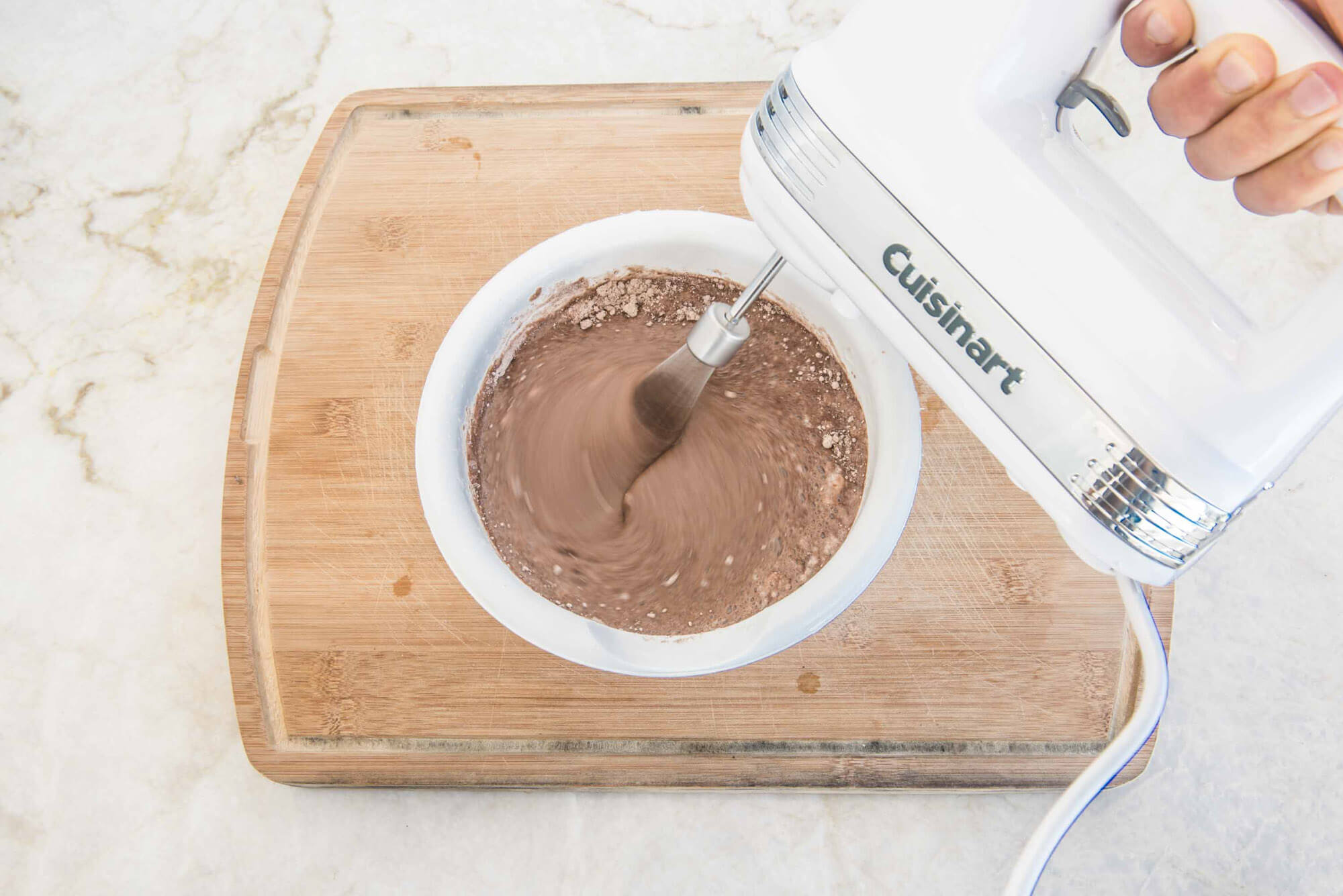
Overall, we decided that a true low, medium-low, medium, medium-high and high are really the only speeds you need for a hand mixer.
Ergonomics
Most of the hand mixers we tested weighed about two pounds (the Vremi was the lightest at only one pound), so they’re designed to be easy to maneuver in a mixing bowl. The Vremi was the easiest to zoom around the bowl, whereas the Oster felt a bit bulky.
Naturally, it’s a personal choice how the mixer fits into your hand, but we discovered that the location of the power/pause and speed level switches are important. When you’re adding ingredients, you want to be able to change speeds or pause the mixer at intervals to ensure thorough mixing. So the switches should be within your thumb’s reach and easy to press.
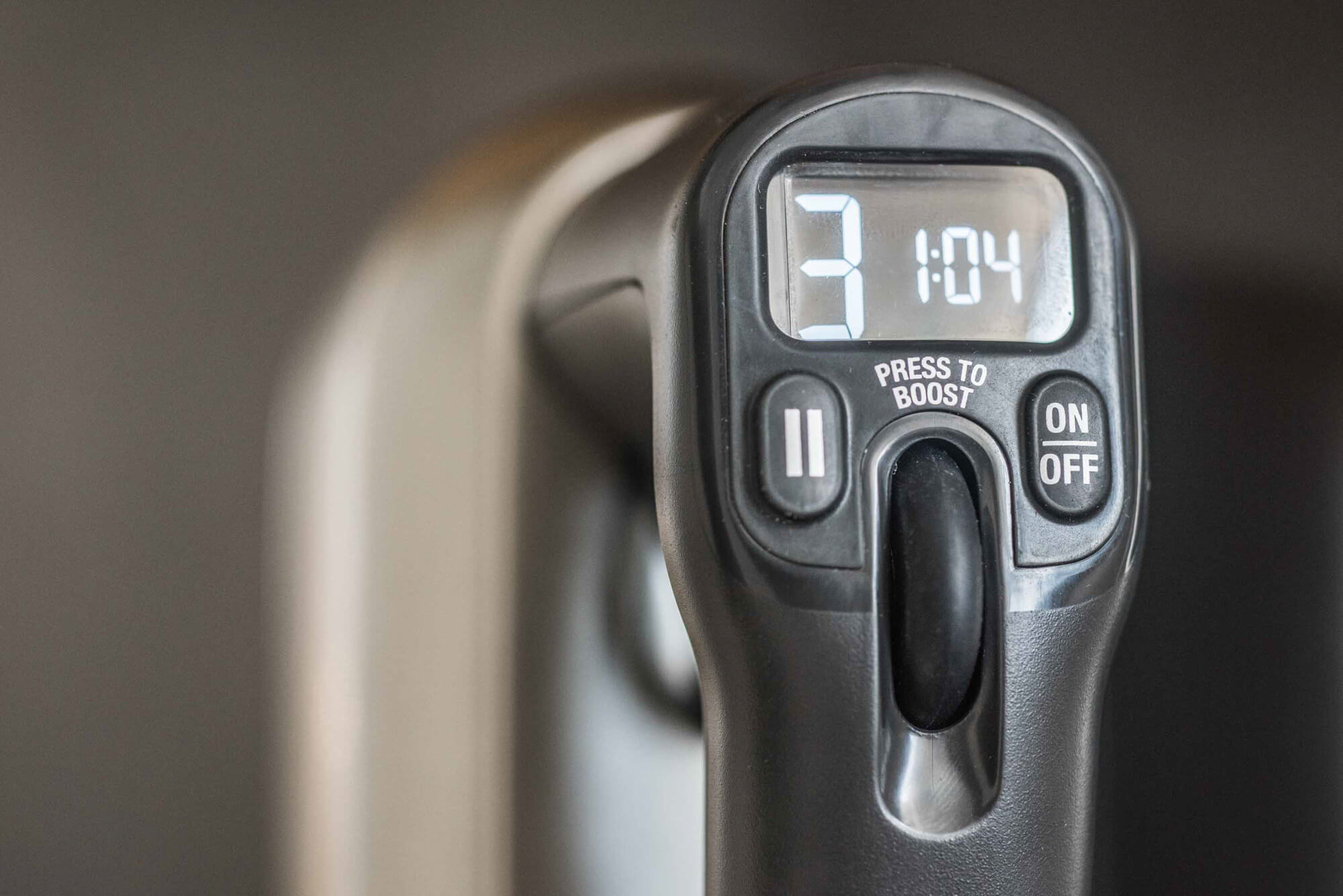
Hands-down, the Breville is the easiest to control with its unique scroll wheel that allows you to change speeds with a flick of your thumb. The Cuisinart and KitchenAid also have easy-to-reach speed controls, but we found the location of their power buttons to be a bit awkward. The other models have levers for speed control, and these proved to be stiff and inexact.
Who needs a hand mixer?
A hand mixer is primarily used for small baking tasks, such as mixing cake batter, creaming butter and sugar or whipping egg whites and heavy cream. Many online comments cite the hand mixer as the perfect appliance for whipping mashed potatoes into an ultra-smooth and fluffy consistency.
Larger baking or cooking tasks are better accomplished with a stand mixer, which allows you to perform several functions completely hands-free. A stand mixer, however, is very heavy and difficult to store anywhere except a countertop, and it lacks portability. Conversely, a hand mixer offers flexibility and can be used in almost any size mixing bowl.
Hand mixer versus immersion blender
An immersion blender or stick blender is ideal for pureeing hot or cold soups, fresh-fruit drinks or smoothies and mayonnaise or other sauces. High-end models, such as the Breville – BSB510XL Control Grip and the KitchenAid – KHB2351, include a whisk attachment. We tested their whisk attachments to determine whether an immersion blender could perform the same whipping tasks as a hand mixer.
In both cases, it took substantially longer to whip cream, since any speed higher than low splattered the cream everywhere. We had more success with egg whites, which didn’t splatter at high speed.
We had two problems with the mashed potatoes: first, it took quite a bit of effort to push down on the potatoes, and second, the immersion blender’s blade pureed the potatoes into a thick and gummy consistency. Good for vichyssoise, perhaps, but terrible for mashed potatoes.
Consequently, we decided that a hand mixer is really a better appliance for these tasks.
The bottom line
Whether you’re a frequent or occasional baker, you’ll want a hand mixer that is reliable, durable and performs all the necessary tasks for baking fluffy cakes and breads and whipping lighter-than-air cream with minimal effort.
We gave our test subjects a rigorous work-out and feel confident that the Breville – BHM800SIL is unquestionably the best hand mixer you could buy. Its smart design features — like a scrolling-wheel speed changer, mixer light, silicone-coated beaters, extra wire whisk — are worth the Breville’s higher price.
If you want a high-quality mixer that’s not as expensive, we recommend our runner-up, the Cuisinart – HM-90S. It’s also a great performer, and you really can’t beat Cuisinart’s three-year warranty.
For under $20, our budget pick, the Oster – 2500 is a sturdy mixer with five clearly differentiated speeds, giving you a true low for splatter-less mixing and blending.
More Reviews
Admetior - T837AH
The Best Dry Food Storage Containers
Progressive - Prepworks
KitchenAid - KSM150P
Zojirushi - BB-PAC20
Toshiba - TL1-AC25CZA(BS)
Whirlpool - WRX 735SDHZ
LEM Products - 1152
The 8 Best Portable (Countertop) Ice Makers
Hamilton Beach - 86150
Cuisinart - DFP-14BCNY
Coleman - 9-Can Soft Cooler

